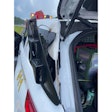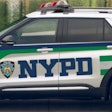Most law enforcement agencies have been through the process of buying and equipping cars many times before. But just because you've done it before doesn't mean you have to do it the same way every time. There are many choices when it comes to outfitting your patrol cars with lightbars, partitions, deck lights, and all the other accoutrements that make cruisers patrol ready. Maybe it's time for your department to look into the different options.
Getting Started
You'll definitely want to include your chief or sheriff, any officers with technical expertise, and a general cross-section of patrol officers when deciding what equipment officers need in their cars to do their jobs. Needs can change each year, so it's important to involve anyone who might have insight into these developments before entering the bid process for buying new cars, which will need to be fully equipped.
What to include in a bid depends on how much you want the dealer to handle and how much you want to take on yourself. As a department you have several options.
Working with Dealers
Most police departments rely on car dealerships to get them the cars they need with the equipment they want. Communicating your expectations to the dealer is an important step in acquiring new patrol cars that are properly equipped to suit your agency.
For example, a smaller department might require different equipment than is specified in the original state bid it's using. A dealer should be willing to come up with a solution to any such issues. Even if you plan on upfitting your cars in house, you'll need the best equipment package to fill in the gaps between the very base model and what your agency will be installing.
"My job is to make sure everything works," says Kevin Buzzard, a fleet dealer at McPeek's Dodge in Anaheim, Calif. "I basically play the middleman. I take what the department wants and then I get with the upfitters and make sure it's all cost effective."
The dealer facilitates the upfitting process. Each agency can decide how deeply it wants the dealer involved in this process. No matter what route you take, he will be the one to deliver new vehicles. It's up to each agency to decide to what degree the cars will be equipped when they arrive from the dealership and who will do the installation.
Turnkey
The most hands-off approach to equipping patrol cars requires almost no involvement from the agency after the bid process. When you rely on a dealer to take care of equipping your agency's patrol cars, most of the work is done for you before you ever see it. Some agencies, especially smaller departments, prefer this solution.
"The dealership is getting the vehicle and subbing it out to a 'subcontractor' for us," explains Chatham County (N.C.) Sheriff Richard Webster. "The dealer has had some questions but, other than that, I don't need to deal with it. The dealership gives me a turnkey price."
If you choose this option you just need to include every item you want in the bid. If you don't specify a certain manufacturer for a particular part, the upfitter the manufacturer uses will choose for you. This is a practice that saves time and often doesn't matter. But if you have a particular preference, make it known.
Webster has found in his two years as head of the Chatham County Sheriff's Office that he prefers to choose the specific equipment that goes onto his patrol cars.
"I was more specific this time because I wasn't happy with the equipment I got two years ago," Webster says. "This time I'm getting brand-name equipment put on the vehicles. I may pay more, but I know I'm getting a quality item."
Once your agency has chosen a dealer to work with via the bid process, your involvement pretty much ends. This is where the dealer steps in and takes over.
A dealer communicates with both the car manufacturer and the shop that will equip or "upfit" the vehicles. Dealers often receive patrol cars from the manufacturer and then deliver them to a local shop to install equipment before delivering them to the agency. But now it's becoming more common for manufacturers to use their own upfitters, so the cars are already equipped when they reach the dealership.
DaimlerChrysler works with Canfield Equipment in Warren, Mich., to outfit patrol cars.
"They're a full upfitter for everything from the ground up," says Dodge dealer Buzzard of Canfield Equipment. "We even ship the radios back to them. They do all the installs and have worked with the IT people at agencies to decide what computer stands they're going to use, and talked with dog handlers to decide what kennels to use for their K-9 units."
Using Canfield Equipment to equip the vehicles, Buzzard says it takes 90 to 100 days for the entire process from receiving the purchase order to delivering the cars to the agency.
"The department's purchase order goes to Chrysler and they build the vehicle in four to six weeks," says Buzzard. "It's then at Canfield for two weeks being equipped and then it's put on the train to come to me."
When the dealer receives the newly equipped cars he may have the vehicles painted at the dealership before delivering them to the agency.[PAGEBREAK]
Half and Half
Many agencies prefer ordering patrol vehicles from a local dealer with a basic police package and then leaving the major equipment installation to a local upfit shop the department contracts with.
The amount of time involved in getting the cars ready to drive is comparable to the time it takes to get a fully equipped vehicle from the dealer. The only difference is who handles the upfitting portion of the process.
Some agencies prefer this type of arrangement because the mechanics who put the equipment on the cars will most likely be the ones to fix them. If the shop is nearby, this will be simple and cost effective.
In-House Installation
Some larger departments have the luxury of running their own garages that handle every aspect of maintaining agency cars, including installing equipment on new vehicles.
Both the police and sheriff's departments in Denver equip and service all of their patrol cars in house. The city's dedicated garage services all cars in the Denver department of safety. And the 17 mechanics who work there take pride in their work.
"We can fully upfit a car in a week," says mechanic Dennis Mazgulski. "We buy the base police police model as it comes from the factory and add everything ourselves."
Mazgulski and his coworkers say that the best way to get the job done is to do it themselves because they can oversee the quality of the work and the amount of time it takes to get the job done.
"If we outsource repairs or upfitting, we're not the first ones in line," Mazgulski says. "We might have to wait and have our cars sit there, which is not efficient."
The Denver garage orders one car each year before ordering the whole fleet so it can check for any changes in the model that could cause them to need modifications to their designs. The garage makes all its own fittings for light bars and other equipment. If there is a change that requires new fittings, the mechanics go to work creating new ones to fit the new model year patrol car. They fully equip the car as a "guinea pig" and ask the fleet supervisors for approval.
Once they get approval, the mechanics create manuals that detail each aspect of the installation process so making repairs later will be simplified. All fleet cars for that year will be equipped in exactly the same way to avoid confusion.
Of course, not everyone has an entire garage dedicated just to one city's public safety agencies. And starting one would prove costly, at least in the beginning stages.
"What we do might not be what's best for all police departments," admits Mazgulski. "We do what's proven best for us. We try to make the cars as safe and as reliable as possible and cost effective."
One trick that any agency can use involves making use of old equipment.
"A lot of departments use cars until there's not much good left in them," says Mazgulski. "We have an idea now of when we can sell cars-and equipment-and actually recoup some of the money. We put it back into our general fund and buy new equipment instead of using everything up until we have to just throw it in the dumpster."
But before selling your equipment, you can probably use it in several different vehicles first. Lightbars and cages often outlast the cars they are used in and might be able to last through five different cruisers, although some modifications might need to be made to make them fit different model years.
Upgrading
Even if you reuse equipment, you'll eventually need to buy new equipment now and then. It's never cheap and it's never completely without hassle. Upgrading vehicles across the board, as when installing new laptops in every cruiser, can't always be done at once. Although a small department might equip each car one by one, the process can be complicated when dealing with a large fleet.
For a large fleet, the installation can be done in one of two ways. The first option is to bring the cars to an upfitter or the in-house garage in rotating groups. This can be done by servicing cars when they are off the street and available.
Alternatively, each car can be upgraded according to its maintenance schedule. Most large agencies follow a preventive maintenance schedule in which each car gets a service "check-up" every two weeks or every month. This is an ideal time to make any modifications to vehicles because it requires no additional downtime for the cars.



















